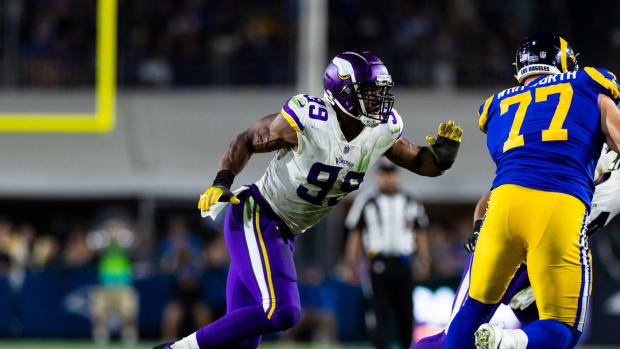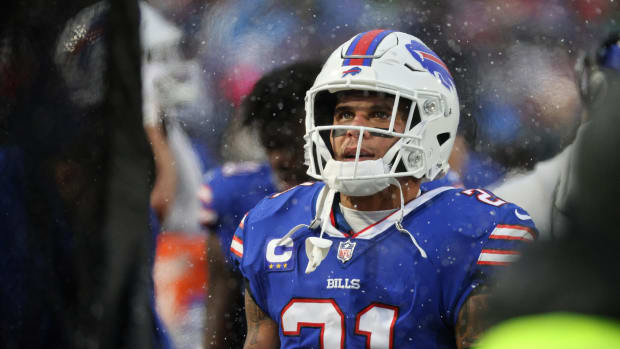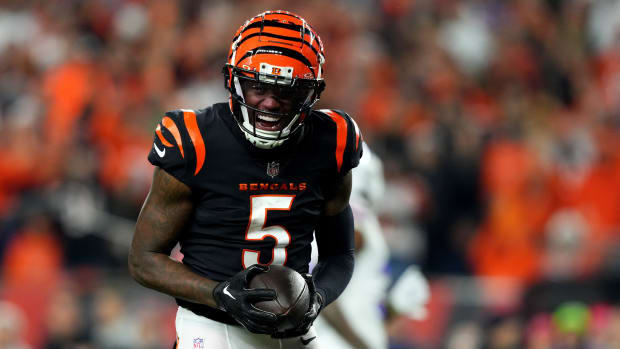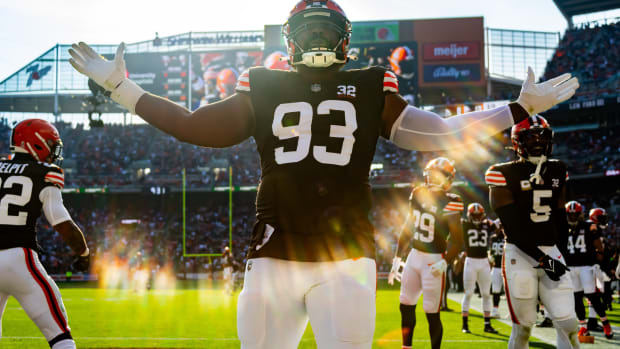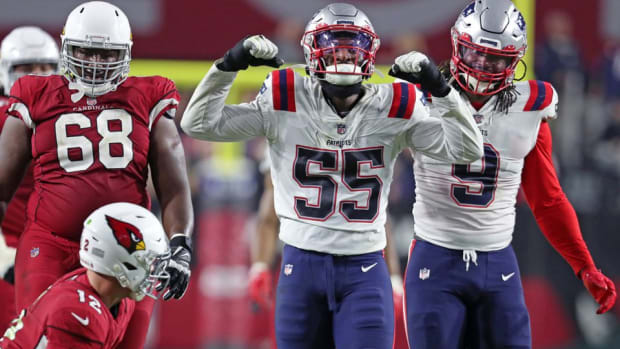Fallout from Latest Allegations Against Panthers Owner Jerry Richardson
As revealed in an SI story on Thursday, there are critical new developments into allegations that Carolina Panthers owner Jerry Richardson engaged in sexual harassment and inappropriate physical contact with at least four women employed by the team. These developments carry legal significance that could alter the trajectory of this controversy.
The controversy became public on Dec. 17, 2017 when Jon Wertheim and Viv Bernstein published a Sports Illustrated investigative report on the accusations. Over the next 48 hours, Richardson declared his intention to sell the Panthers, removed himself from operational control and elevated Tina Becker, who had been executive director of the owner’s office, to chief operating officer. The Panthers also quickly announced an internal investigation, but a hastily assembled NFL probe into Richardson subsumed it. As questions surfaced about how Richardson could have behaved so poorly and for so long without repercussions, one certainty emerged: in the height of the #MeToo movement, one of the most powerful NFL owners had been toppled by allegations of personal misconduct.
On March 25, Houston Texans owner Bob McNair told ESPN writer David Newton that Richardson had regretted not challenging the accusations. McNair’s account suggested that Richardson had publicly caved to charges that he privately disputed. McNair indicated that Richardson’s overtures to female employees had simply been “misunderstood” and that Richardson never intended any harm. McNair also observed that Richardson seemed to lament relying on the advice of his attorneys and insurers to quickly wave a white flag. These and other risk-averse persons were, as relayed by McNair, interested more in minimizing Richardson’s legal and financial exposure than in waging a fight on his behalf.
At least one of Richardson’s alleged victims read the ESPN story with great interest and dismay. In My Truth in Letters, the author—who has withheld her name on account of signing a non-disclosure agreement with Richardson—offers a first-person account of her experience with Richardson and her views on how the controversy has played out. She pens six different letters, each addressed to a different person or group: McNair, the NFL, the “enablers”, Panthers coach Ron Rivera, Richardson and the yet-to-be-determined future majority owner of the Panthers. The six letters reveal her frustration as to the decision-making of persons supposedly entrusted with holding Richardson accountable.
There are five key legal implications from the letters:
1. Richardson could have violated non-disclosure agreements
Several accusers of Richardson have signed non-disclosure agreements (NDAs) with the Panthers. The accusers signed them pursuant to their employment and as a condition of their severance from the team.
The fact that Panthers employees and ex-employees signed NDAs is not itself indicative of wrongdoing. NDAs are relatively common among American businesses. They often concern a company’s trade secrets and other proprietary information. NDAs are usually designed to deter employees from divulging knowledge that supplies the company with a competitive advantage. This is true in professional sports. An NFL team, for example, does not want to see its unique analytics formulas travel with departing employees, particularly if they join rival teams.
NDAs create contractual obligations on the part of employees, and sometimes of employers, to refrain from disclosing information specifically covered by the NDAs. Typically the employee (or former employee) is paid an amount of money to never speak again about a particular topic. In most cases NDAs are neither disputed nor breached. However, if an employee or former employee breaches the NDA, the company can then sue him or her for breach of contract. If such a lawsuit were successful, a court could order the person to repay the company whatever amount of money had been paid in the NDA. Depending on the circumstances, the person could also be ordered to pay the company additional monetary damages.
NDAs have become controversial over the last two years because of their connection to the #MeToo movement. Some NDAs have been used for what many consider to be unethical, if not unlawful, purposes. Namely, NDAs have been designed to protect company executives from the fallout of allegations—or even admissions—that they engaged in sexual misconduct with employees. While lawmakers in several states are exploring ways to deny the enforceability of NDAs connected to sexual misconduct, such laws have not yet been enacted. These types of NDAs were signed by former employees of film producer and accused rapist Harvey Weinstein, as well by Olympic gold medalist McKayla Maroney in the aftermath of being sexually assaulted by USA Gymnastics doctor Larry Nassar. Panthers employees who accused Richardson of misconduct signed NDAs and thus became contractually bound to not reveal their experiences.
It’s unclear if NDAs signed by Richardson’s accusers and the Panthers were “unilateral” or “mutual.” If unilateral, it would mean that while the accusers are contractually barred from revealing information about their experience with Richardson, the team and its officials are not. In contrast, if the NDAs are mutual, both the accuser and team—including Richardson—would be bound to remain silent. If the NDA was mutual, Richardson talking to McNair and other owners about the allegations could, depending on the details he shared, run afoul of the NDA. If Richardson only denied public accounts of his behavior, he might not have violated the NDA since the denials concerned public information. It is worth noting that in her letter to McNair, the alleged victim urges him to let Richardson know that he “broke the NDA signed.” She reaches this conclusion based on Richardson sharing his side of the story with McNair and other owners.
If Richardson breached the NDAs, his accusers could construe those NDAs as invalid and unenforceable (it is also possible Richardson could reach the same determination given that some of his accusers have gone public, albeit anonymously). The accusers could then openly share their views. Richardson’s accusers could also sue both Richardson and the Panthers for breach of their NDAs and seek monetary damages. Such litigation would prolong the controversy for both the Panthers and the NFL long after someone else replaces Richardson as majority owner.
2. Richardson placed his team’s top attorney in an awkward, if not conflicted, position to deflect damaging allegations directed at Richardson
According to the accuser who has authored My Truth in Letters, Panthers general counsel Richard Thigpen negotiated and signed her NDA. At first glance, Thigpen’s involvement in the NDA is not surprising. The team is potentially liable to the accuser, who could sue the Panthers for sexual harassment and hostile work environment. Such a lawsuit would assert that team officials knew about the misconduct of Richardson—whose name had appeared at the top of the company’s masthead until several months ago—and unreasonably failed to take corrective steps. Thigpen would have been expected to play an instrumental role in shaping an NDA so that the NDA minimized his employer’s chances of liability.
To the extent Thigpen also represented Richardson in negotiating the NDA, Thigpen may have felt tension as to whose interests he represented. While the 81-year-old Richardson owned a majority of the Panthers at the time the NDA was negotiated, other persons and families had minority ownership stakes in the team. This is significant since the team’s financial and legal interests are separate from those of Richardson, whose personal liability in any lawsuit would be disaggregated from that of the team.
Along those lines, Thigpen and other Panthers officials work for the team, not the majority owner or the minority owners. These officials likely realized that if the sexual assault allegations against Richardson ever became public, the NFL could undertake various actions impacting the team and Richardson personally. For instance, the league could have issued fines or suspensions, or pressured Richardson to sell the team—a move that would influence the value of the minority ownership interests. This complicated arrangement placed Panthers officials and Richardson in positions that may not have been entirely congruous.
Richardson using the team’s general counsel to respond to allegations against him also raises questions about the appropriate use of team resources. While the general counsel would need to play a role given the team’s exposure to liability stemming from Richardson’s alleged behavior, it’s not clear if Richardson—whose net worth is reportedly in excess of $1 billion—retained his own private attorney. As noted above, Richardson’s interests are connected to the team but are nonetheless separate and potentially in conflict.
3. The Panthers appear to have violated the NFL Personal Conduct Policy
Although typically discussed in the context of player conduct, the NFL’s personal conduct policy applies to all NFL personnel. This classification includes players, coaches, other team employees, game officials, league officers and—yes—owners. All of these persons are obligated to refrain from “conduct detrimental to the integrity of, or public confidence in, the game of professional football.” NFL commissioner Roger Goodell can interpret this open-ended language as he sees fit. He has done so to impose punishments for a range of conduct matters, including serious ones involving domestic violence and less troubling ones involving equipment rules. To be sure, the allegations against Richardson—which included that he gave sexually charged back rubs, brushed his hands across women’s breasts and uttered a racial slur against an African-American employee—would warrant the commissioner’s attention and potentially lead to punishment.
However, it does not appear that the NFL was ever made aware of these allegations. As the piece details, the NFL abruptly took over the Panthers’ internal investigation into Richardson within 48 hours of the SI story breaking. The league retained Mary Jo White, a former U.S. attorney and Securities and Exchange Commissioner, to run the investigation, which continues to this day. Had the league known about Richardson’s alleged misconduct, it presumably would have opened up an earlier probe.
Also, the Panthers appear to have had a contractual duty under the personal conduct policy to inform the NFL of Richardson’s misconduct. Per the policy, “clubs must report any potential violation that comes to their attention whether through law enforcement, a witness, a victim or other source. The responsibility to report is required and will be strictly enforced. Failure to report an incident will be grounds for disciplinary action.” Given that the Personal Conduct Policy governed Richardson, the Panthers seemingly had a duty to notify the NFL of allegations of “conduct detrimental” involving Richardson. While it may seem awkward, if not unwise in terms of job security, for employees of a team to tell on their team’s owner, they had a job to do so under NFL rules. And if they failed to do so, their team could be in more trouble as a result. The league could consider punishments in the form of fines and forfeited draft picks.
It’s less clear whether the Panthers had to notify the NFL about NDAs signed by the team and Richardson’s accusers. The Panthers could argue that Panthers employees who are not players have no contractual relationship with the NFL. These employees are not unionized and do not collectively bargain with the league. Further, the NFL plays no role in approving employment contracts and other legal instruments negotiated between teams and its non-player employees. While the league plays a limited role in team hiring through the Rooney Rule, which requires NFL teams interview minority candidates for certain positions, the Rooney Rule is not at issue in this controversy.
In addition, each NFL team has some degree of autonomy in managing its internal team issues. The NFL, however, could insist that such autonomy erodes when those internal team issues become league controversies. Inappropriate conduct accusations against Richardson—particularly in the context of the #MeToo movement—are clearly of interest to the NFL. This was apparent when the NFL pushed the Panthers and its investigators aside to conduct the investigation.
4. The NFL has limited authority to force Richardson to cooperate but has leverage over the Panthers
The NFL is not the government or law enforcement. It can’t subpoena records, execute search warrants or force Panthers executives and employees to testify under oath. It can lean on contractual obligations of the Panthers to comply with league investigations but that is a weaker legal authority. While there is no indication that Panthers executives have been unwilling to cooperate with White and the NFL, they would have some reason to adopt such an approach. They know that sharing damaging materials could expose the team to liability since Richardson’s accusers could still sue the team.
In fact, until the relevant statutes of limitations expire, the team could be sued on account of Richardson even after he leaves the team. The team is thus incentivized to object to sharing emails and other electronic records on grounds that it constitutes an invasion of privacy. The league may therefore be limited in trying to obtain any videos, texts, emails and other evidence relevant to accusations against Richardson.
On the other hand, the league has certain leverage over the Panthers by virtue of its power to punish. Under the NFL constitution, which governs the legal relationship between teams and the league, the NFL can levy fines and suspensions against the Panthers and Richardson. The NFL could do so if it finds the Panthers to be uncooperative. Of greater influence, the NFL could strip away draft picks from the Panthers. The NFL suspending or fining Richardson is probably an empty threat at this point since the team will sell in the coming weeks. Conversely, the NFL threatening to take away Panthers draft picks would be anything but an empty threat.
The league could also demand cooperation as a condition of authorizing the forthcoming sale of the Panthers. Three-quarters of owners are required to approve the sale of a team.
Jerry Richardson’s Tarnished Legacy: Under a Cloud, Selling the Team That Made Him an Icon
5. The NFL could indemnify the accuser so she can talk
The accuser who has authored My Truth in Letters asserts that her attorney spoke with White and offered her cooperation in the league investigation. According to the accuser, however, while White “said she would like to hear my truth”, White told her that neither “she nor [the NFL] could protect me from the penalties of breaching my NDA.” The accuser found White’s response to contradict the league’s stated intentions of aggressively investigating what happened. “Let me get this straight,” the accuser writes. “You say you are doing a thorough investigation of ‘workplace misconduct’ of Jerry Richardson . . . but you cannot protect me. Got it. You have zero power, and that makes your investigation a farce.”
While the NFL can’t protect the accuser from being sued over a breached NDA, it could offer to indemnify her from the consequences of such a lawsuit. The league could pledge to pay any legal expenses she incurs if the Panthers or Richardson sues her for breach of an NDA. If the NFL, which generates about $14 billion a year in revenue, wants to hear from the accusers, it clearly has the financial wherewithal to make that happen.
Indemnity agreements are hardly unprecedented in sports. During the Donald Sterling saga in 2014, the NBA demanded and received from Sterling’s wife, Shelly Sterling, indemnification from any litigation costs associated with her husband suing the league and NBA commissioner Adam Silver. This arrangement facilitated the sale of the Los Angeles Clippers from the Sterling Family Trust to Steve Ballmer. It also ensured that if Donald Sterling prevailed in his lawsuits against the NBA and Silver—he didn’t—his own family trust would ultimately be on the hook to pay him. The NFL might want to borrow a play from the NBA’s legal playbook.
Michael McCann is SI's legal analyst. He is also the Associate Dean for Academic Affairs at the University of New Hampshire School of Law and co-author with Ed O'Bannon of the new book Court Justice: The Inside Story of My Battle Against the NCAA.

































